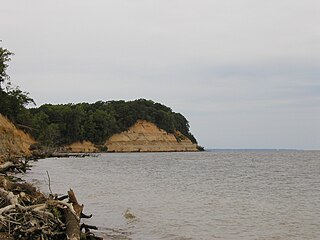
Calvert Cliffs State Park is a public recreation area in Lusby, Calvert County, Maryland, that protects a portion of the cliffs that extend for 24 miles along the eastern flank of the Calvert Peninsula on the west side of Chesapeake Bay from Chesapeake Beach southward to Drum Point. The state park is known for the abundance of mainly Middle Miocene sub-epoch fossils that can be found on the shoreline.
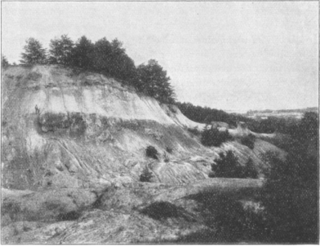
The Potomac Group is a geologic group in Delaware, Maryland, New Jersey, and Virginia. It preserves fossils dating back to the Cretaceous period. An indeterminate tyrannosauroid and Priconodon crassus, a nodosaurid, are known from indeterminate sediments belonging to the Potomac Group. The Potomac Group was initially believed to have been Late Jurassic in age by Othniel Charles Marsh but later studies, such as Clark (1897), have found that the Potomac Group is in fact Early-Late Cretaceous (Aptian-Turonian) in age.

The Rockdale Run Formation is a geologic formation in Maryland, Pennsylvania, Virginia and West Virginia. It preserves fossils dating back to the Ordovician period.
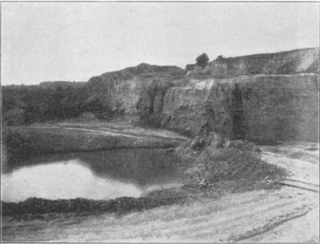
The Patapsco Formation is a geologic formation of varigated clays, sandy clays, and sand in Virginia, the District of Columbia, Maryland, Delaware, Pennsylvania, and in the subsurface of New Jersey. It preserves fossils such as plants and molluscs dating back to the Cretaceous period.
The St. Marys Formation is a geologic formation in Maryland and Virginia, United States. It preserves fossils dating back to the Miocene Epoch of the Neogene period. It is the youngest Miocene formation present in the Calvert Cliffs and is part of the Chesapeake Group.

The Old Church Formation is a geologic formation in Virginia and possibly Maryland. It preserves fossils dating back to the Oligocene epoch of the Paleogene period. It rarely exposes on land and is under-studied. However, deposits from this period are rare and the Old Church Formation likely contains many scientifically significant taxa. Ward (1985) recommended placing this formation in the Chesapeake Group.

The Choptank Formation is a geologic formation in Virginia and Maryland. It preserves fossils dating from the Miocene epoch of the Neogene period.
The Piney Point Formation is a geologic formation in Virginia. It preserves fossils dating back to the Lutetian Stage of the Eocene Epoch of the Paleogene period.
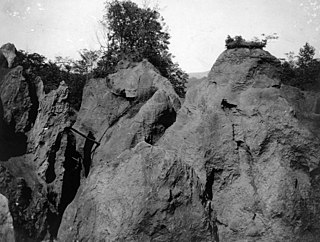
The Tomstown Dolomite or Tomstown Formation is a geologic formation in Maryland, Pennsylvania, Virginia and West Virginia. It preserves fossils dating to the Cambrian Period.
The Alum Bluff Group is a geologic group in the states of Georgia, Florida, and Alabama. It preserves fossils dating back to the Neogene period.

The Bone Valley Formation is a geologic formation in Florida. It is sometimes classified as the upper member of the Peace River Formation of the Hawthorn Group. It contains economically important phosphorite deposits that are mined in west-central Florida, as well as rich assemblages of vertebrate fossils.

The Monarch Mill Formation is a geologic formation in Nevada, United States. It preserves fossils dating back to the Neogene period.
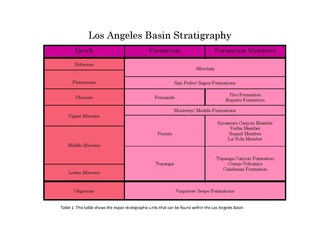
The Puente Formation is a geologic formation in California. It preserves fossils dating back to the middle to upper Miocene epoch of the Neogene period.
The Crowder Formation is a geologic formation in the Central and Western Mojave Desert, in northern Los Angeles County and eastern San Bernardino County, in Southern California.
The Modelo Formation is a Miocene geologic formation in the Simi Hills and western Santa Susana Mountains of southern California.
The Topanga Canyon Formation is a Miocene epoch geologic formation in the Santa Monica Mountains, Simi Hills, Santa Ana Mountains and San Joaquin Hills, in Los Angeles County, Ventura County, and Orange County, southern California. It is primarily composed of hard sandstone with some inter-bedded siltstone.

The Santa Margarita Formation is a Neogene Period geologic formation in the San Joaquin Valley of central California.

Alopias palatasi commonly referred to as the serrated giant thresher, is an extinct species of giant thresher shark that lived approximately 20.44 to 13.7 million years ago during the Miocene epoch, and is known for its uniquely serrated teeth. It is only known from such isolated teeth, which are large and can measure up to an excess of 4 centimetres (2 in), equating to a size rivaling the great white shark, but are rare and found in deposits in the East Coast of the United States and Malta. Teeth of A. palatasi are strikingly similar to those of the giant thresher Alopias grandis, and the former has been considered as a variant of the latter in the past. Scientists hypothesized that A. palatasi may have had attained lengths comparable with the great white shark and a body outline similar to it.

The Calvert Formation is a geologic formation in Maryland, Virginia, and Delaware. It preserves fossils dating back to the early to middle Miocene epoch of the Neogene period. The formation is a destination for amateur fossil hunters as well as professional paleontologists. It is one of the three formations which make up the Calvert Cliffs, all of which are part of the Chesapeake Group.













